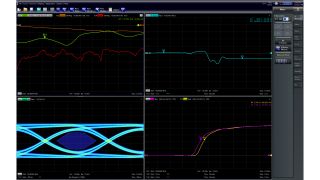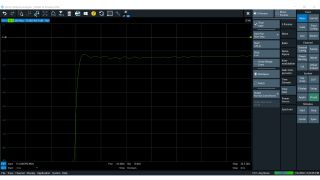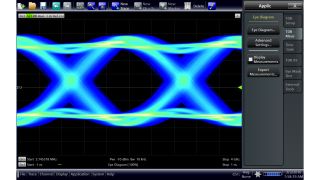Key facts
- Rise time resolution from 9 ps
- Formats: lowpass impulse and step, bandpass impulse
- Windowing/time gates: rectangular, hamming, Hann, Bohman, Dolph-Chebychev
- Signal integrity test function with eye diagram


Key facts
The time domain and distance-to-fault options display discontinuities, reflection factors or impedance versus delay/length. The TD option includes step and impulse response, lowpass/bandpass, frequency spacing and gated S-parameters. A wide selection of windows can be used to optimize the time domain response and suppress sidelobes due to the finite sweep range. Time gating and transforming back to the frequency domain eliminates unwanted responses.
The right format for the right application
The Rohde & Schwarz time domain option supports the following formats: lowpass impulse and step, bandpass impulse. The easy-to-use bandpass mode works with any set of a harmonic grid. The lowpass mode offers higher resolution factors in the DC value information.

Optimize measurement results with windowing and gating
The finite sweep range in frequency domain measurements with discontinuous transitions at the start and stop frequency broadens the impulses and causes sidelobes (ringing) in the time domain response. Windowing can reduce this effect and optimize the time domain response. A time gate is used to eliminate unwanted responses that appear on the time domain transform. An active time gate acts on the trace in time domain and frequency domain representations.

Valuable insights into the signal integrity of your design
The enhanced time domain option enables the R&S®VNA to implement a "virtual" signal generator for generating multilevel PAM signals (NRZ, PAM-4, PAM-8, PAM-16), including simulated lowpass behavior. The eye diagram calculated from the DUT's measured S-parameters provides an extensive overview of the system's signal integrity. Further building blocks for pre-emphasis, jitter, noise and equalization enable synthesization of the transmission system's transmitter and receiver parts.

Optimum resolution for optimum results
The Rohde & Schwarz time domain options offer a minimum resolution of up to 18 ps with an ambiguity range of up to 1.5 µs depending on the instrument of choice. Rise time resolution is as narrow as 9 ps. For more information, see the comparison table.
Order number 1332.5336.02
Order number 1164.1657.02
Order number 1316.0156.02
Order number 1318.8425.02
Order number 1328.5393.02
Order number 1306.0201.02
Order number 1323.1819.02
Order number 1351.5367.02

Order number 1332.4746.02
Extended time domain analysis
incl. eye diagram, for R&S®ZNA
Order number 1326.8072.02
Extended time domain analysis
Order number 1319.4400.02
Extended time domain analysis with eye diagram
Order number 1351.5373.02
Extended time domain analysis


